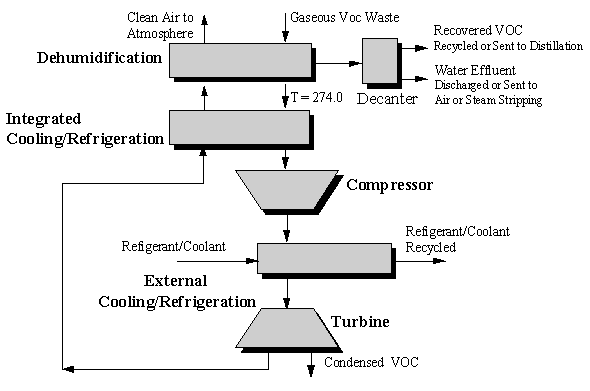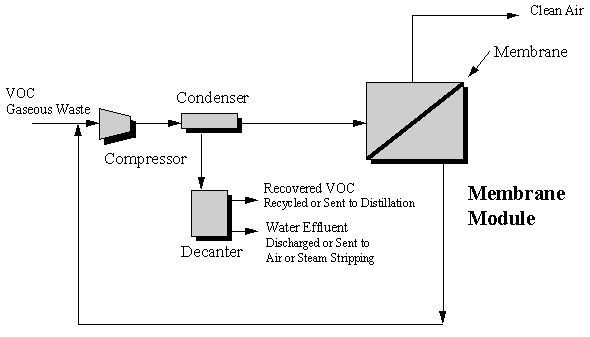

|
|

|
|

Dunn, Russell F., M. Zhu, B. K. Srinivas, and M. M. El-Halwagi, Optimal Design of Energy-Induced Separation Networks for VOC Recovery, AIChE Symposium Series: Pollution Prevention via Process and Product Modifications, 90(303), 74-85, 1995.
Dunn, Russell F. and Mahmoud M. El-Halwagi, Optimal Design of Multi-Component VOC Condensation Systems, J. Haz. Mtls., 38, 187-206, 1994a.
Dunn, Russell F. and Mahmoud M. El-Halwagi, Selection of Optimal VOC-Condensation Systems, Waste Mgt., 14(2), 103-113, 1994b.
Geankoplis, C. J., Transport Processes and Unit Operations, Second Edition, Allyn and Bacon, Inc., Boston, 1983.
Heilshorn, E.D., Removing VOC's from Contaminated Water-Part One, Chemical Engineering, 98(2), 120-124, 1991a.
Heilshorn, E.D., Removing VOC's from Contaminated Water-Part One, Chemical Engineering, 98(3), 152-158, 1991b.
Henley, E. J. and J. D. Seader, Equilibrium-Stage Separation Operations in Chemical Engineering, John Wiley and Sons, New York, 1981.
King, C. J., Separation Processes, Second Edition McGraw-Hill, New York, 1980.
McCabe, W. L., J. C. Smith and P. Harriot, Unit Operations of Chemical Engineering, Fifth Edition, McGraw-Hill, New York, 1993.
McInnes, Robert G., Explore New Options for Hazardous Air Pollution Control, Chemical Engineering Progress, 91(11), 36-48, 1995.
Moretti, E. C. and Mukhopadhyay, N., 1993, VOC Control: Current Practices and Future Trends, Chemical Engineering Progress, 89(7), 20-26, 1993.
Perry, R. H. and D. Green, Perry's Chemical Engineers' Handbook, Sixth Edition, McGraw-Hill, New York, 1984.
Ruddy, E. N. and Carroll, L. A., Select the Best VOC Control Strategy, Chemical Engineering Progress, 89(7), 28, 1993.
Simmons, Vicki, Jurgen Kaschemekat, Marc L. Jacobs and David D. Dortmundt, Membrane Systems Offer a New Way to Recover Volatile Organic Air Pollutants,Chemical Engineering, 101(9), 92-94, 1994.
Stenzel, M. H., Remove Organics by Activated Carbon Adsorption, Chemical Engineering Progress, 89(4), 36-43, 1993.
Treybal, R. E., Mass Transfer Operations, Second Edition, McGraw-Hill, New York, 1980.
U. S. Environmental Protection Agency, Control Technologies for Hazardous Air Pollutants, EPA/625/6-91/014, 1991.
In the 1970's, the main environmental activity of chemical processes was end-of-the-pipe treatment. This approach is based on installing pollution control units that can reduce the composition of contaminants in waste streams to acceptable levels. Most of these units employ destructive techniques that convert the contaminants into more benign species (e.g. incineration, biotreatment, etc.). In the 1980's, the chemical process industries have shown a strong interest in implementing recycle/reuse policies in which pollutants are recovered from terminal streams (typically using separation processes) and reused or sold. This approach has gained significant momentum due to the realization that "waste streams and pollutants" may be valuable materials that can be recovered in a cost-effective manner. Since separation systems are essential in recycle/reuse policies, the past few years have witnessed considerable progress in the area of designing separation networks for waste recovery. In particular, the powerful concepts of process integration and synthesis were developed to systematically accomplish the following:
To utilize this design concept, the designer must have the capability of identifying the optimal process configuration without enumerating all design possibilities. In addition, the designer must be aware that a design based on heuristics (what has worked in the past for a similar separation task) will almost certainly identify a non-optimal design that results in higher cost to the company than should have been necessary. Two major problems exist with a heuristic based design approach. First, this approach assumes that what was previously employed for a separation task was the most cost-effective approach. Second, new emerging technologies (such as membrane separations) may not possess a wealth of previous process applications. This in no way is an indication that this new technology should not be incorporated in a current optimal process configuration.
To apply this approach to the design of VOC recovery systems the designer must be aware of two key points. First, the designer must recognize that several process scenarios exist for satisfying a desired separation task. For instance, for VOC aqueous wastes as indicated in chapter 2, air stripping, steam stripping, activated carbon adsorption, reverse osmosis and/or pervaporation, can be employed separately, or in the form of some combined hybrid process, to separate the VOC from the wastewater. Second, the designer must understand that the thermodynamic effectiveness (not necessarily related to the cost effectiveness) of the system is based on the system equilibrium data. Once the designer understands these two principles, it should become apparent that the number of process designs that are applicable for the separation task are too numerous to envision. In fact, a common design approach has been to envision several process scenarios, perform design calculations for the scenarios to determine process flowrates and equipment sizes, and then determine the economics associated with each design scenario. A common trap is then to designate the least cost scenario as the "optimal" design, when in fact the true optimal design (lowest cost of any process scenario) in many cases may not be one of the originally envisioned scenarios.
The critical question is: How can the designer effectively screen infinite process scenarios to identify the true optimal (minimum cost) design?
The design tools presented below address this question.
Process synthesis is an emerging field of study in engineering designed to answer the above question. Process synthesis is the integration of all process elements to generate the optimal process configuration (overall process design) that meets certain objectives (minimize annualized cost, minimize waste emissions, maximum energy efficiency, etc.).
Process synthesis tools provide a systematic framework for tackling numerous process design tasks. Several generic process design tools have been developed to date and two are particularly applicable to the design of VOC separation systems for aqueous wastes. These tools are the Design of Mass-Exchange Networks (El-Halwagi and Manousiouthakis, 1990a, 1990b, 1991; El-Halwagi and Srinivas, 1992; Srinivas and El-Halwagi, 1994) and the Design of Membrane Systems (El-Halwagi, 1992, 1993; Srinivas and El-Halwagi, 1993) . Several generic process design tools have also been developed to date that are particularly applicable to the design of VOC separation systems for gaseous wastes. These tools are the Design of Mass Exchange Networks, the Design of Energy-Induced Separation Networks (Dunn et al., 1995; El-Halwagi et al., 1994; Richburg and El-Halwagi, 1994) and the Design of Membrane-Hybrid Networks (Crabtree et al., 1995). The use of these tools, along with example case studies, for aqueous and gaseous VOC wastes will be covered in chapters 6 and 8, respectively.
Crabtree, Eric, R. F. Dunn and M. M. El-Halwagi, Synthesis of Membrane/Condensation Hybrid Systems for Solvent Recovery, 1995 North American Membrane Society Annual Meeting, Portland, 1995.
Dunn, R. F., M. Zhu, B. K. Srinivas, and M. M. El-Halwagi, Optimal Design of Energy-Induced Separation Networks for VOC Recovery, AIChE J. Symp. Series, 90(103), 74-85, 1995.
El-Halwagi, M. M., B. K. Srinivas and R. F. Dunn, Synthesis of Optimal Heat-Induced Separation Networks, Chem. Eng. Sci., 50(1), 81-97, 1995.
El-Halwagi, M. M., Optimal Design of Membrane Hybrid Systems for Waste Reduction, Sep. Sci. Tech., 28(1-3), 283-307, 1993.
El-Halwagi, M. M., Synthesis of Optimal Reverse-Osmosis Networks for Waste Reduction, AIChE J., 38(8), 1185-1198, 1992.
El-Halwagi, M. M. and B. K. Srinivas, Synthesis of Reactive Mass-Exchange Networks, Chem. Eng. Sci., 47(8), 2113-2119, 1992.
El-Halwagi, M. M. and V. Manousiouthakis, Automatic Synthesis of Mass Exchange Networks with Single-Component Targets, Chem. Eng. Sci., 45(9), 2813-2831, 1990a.
El-Halwagi, M. M. and V. Manousiouthakis, Simultaneous Synthesis of Mass Exchange and Regeneration Networks, AIChE J., 36(8), 1209-1219, 1990b.
El-Halwagi, M. M. and V. Manousiouthakis, Synthesis of Mass Exchange Networks, AIChE J., 35(8), 1233-1244, 1989.
Richburg, Andrea and Mahmoud M. El-Halwagi, 1994, A Graphical Approach to the Optimal Design of Heat-Induced Separation Networks for VOC Recovery, Foundations in Computer-Aided Process Design, 1994
Srinivas B. K. and M. M. El-Halwagi, Synthesis of Combined Heat and Reactive Mass-Exchange Networks, Chem. Eng. Sci., 49(13), 2059-2074, 1994.
Srinivas, B. K. and M. M. El-Halwagi, Optimal Design of Pervaporation Systems for Waste Reduction, Comp. Chem. Eng., 17(10), 957-970, 1993.
In order to design a recovery system for aqueous VOC wastes using any of the previously described technologies, it is necessary to determine equilibrium data for the technology considered. Accurate experimental results provide the most reliable source for equilibrium data. If not available, empirical correlations for predicting equilibrium data may be invoked. These correlations are particularly useful at the conceptual-design stage. Several literature sources provide compilations of equilibrium data and correlations. Examples of these sources include Lo et al. (1983) as well as Francis (1964) for solvent extraction, Reid et al. (1977) for vapor-liquid and liquid-liquid systems, Breton et al. (1988) for liquid extraction, carbon adsorption and air stripping, Hwang et al. (1992) for steam stripping, Mackay and Shiu (1981), Fleming (1989), Clark et al. (1990) and Yaws (1992) for air stripping, US EPA (1980), Perrich (1981), Valenzuela (1989), Stenzel and Merz (1989) and Stenzel (1993) for adsorption.
Breton, M., et. al., Treatment Technologies for Solvent Containing Wastes, Noyes Data Corporation, New York, 1988.
Clark, R. M., et. al., Chapter 15: Unit Process Research for Removing Volatile Organic Chemicals from Drinking Water: An Overview in Ram, Neil M., Russell F. Christman, and Kenneth P. Cantor, Significance and Treatment of Volatile Organic Compounds in Water Supplies, Lewis Publishers, Chelsea, MI, 1990.
Fleming, J. L., Volatilization Technologies for Removing Organics from Water, Noyes Data Corporation, Park Ridge, NJ, 1989.
Francis, A. W., Liquid-Liquid Equilibrium, Interscience Publishers, New York, 1963.
Hwang, Y., J. D. Olson and G. E. Keller, II Steam Stripping for Removal of Organic Pollutants from Water: Parts 1 and 2, Ind. Engineering Chemistry Research, 31(7) 1753-1768, 1992.
Lo, T. C., M. H. I. Baird, and C. Hanson, Handbook of Solvent Extraction, Wiley-Interscience, New York, 1983.
Mackay, D. and W. Y. Shiu, A Critical Review of Henry's Law Constants for Chemicals of Environmental Interest, J. Phys. Chem. Ref. Data, 10(4), 1981, pp. 1175-1199
Perrich, J. R., Activated Carbon Adsorption for Wastewater Treatment, CRC Press Inc., Boca Raton, FL, 1981.
Reid, R. C., The Properties of Gases and Liquids, McGraw-Hill, New York, 1977.
Stenzel, M. H. Remove Organics by Activated Carbon Adsorption, Chemical Engineering Progress, 89(4), 36-43, 1993.
Stenzel, M. H. and W. J. Merz, Use of Carbon Adsorption Processes in Groundwater Treatment, Environmental Progress, 8(4), 257-264, 1989.
United States Environmental Protection Agency, Carbon Adsorption Isotherms for Toxic Organics, Cincinnati, Ohio, EPA-600/8-80-023, April, 1980.
Valenzuela, D. P. and A. Myers, Adsorption Equilibrium Data Handbook, Prentice-Hall Inc., Englewood Cliffs, NJ, 1989.
Yaws, C. L., Thermodynamic and Physical Property Data, Gulf Publishing Company, Houston, TX, 1992.